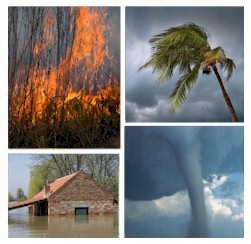|
|


Disaster Alert Systems
 This section of our technical library presents articles written about Emergency Alert Systems and Disaster Recovery definitions, terms and related information.
This section of our technical library presents articles written about Emergency Alert Systems and Disaster Recovery definitions, terms and related information.
The 911Broadcast emergency notification and alert service can deliver a large number of phone calls using a network of phone systems employing digital phone lines simultaneously. Should a disaster such as a snow storm, wild fire or flood hit your area, 911Broadcast systems can alert your community quickly providing specific instructions if an evacuation is required.
This service is available using our emergency broadcasting systems. If a dangerous chemical spill occurs in your community, you can target specific areas to call. If a severe snow storm hits your area, your community can be notified of school closings or event cancellations.
Developing a State of Oregon - All Hazards Warning System
Galen Howard, Principal Planner, Lane Council of Governments
Background
Across Oregon and across the Country agencies responsible for public safety are developing
plans which address how citizens are to be alerted to an imminent manmade or natural threat.
Systems are being acquired that can quickly call lists of public safety personnel, apprise them of
the situation and provide response instructions. Agencies in need of alerting and information
distribution systems include public health, emergency management, police, fire, emergency
medical, public utility, port authority, airports, civil and national defense agencies, forest service,
FAA, FBI, CIA, Amy Corps of Engineers and others.
The events of September 11th highlighted weaknesses in the readiness and effectiveness of our
public safety communication and response systems. The experience requires the public safety
community to act and develop improvements to meet future threats.
There exists proven communication system technology that can target thousands of telephone users a
minute of a pending disaster or provide directions to first responders and public safety personnel on
predetermined call lists. These high capacity, map based systems have only been available for the
last few years and rely on telephone utility data bases developed for the location identification feature
of Enhanced 9-1-1. Updated daily, the Enhanced 9-1-1 data base includes unlisted/unpublished
telephone numbers. An automated message system can provide specific instructions to shelter inplace,
listen for reports on TV/radio, or to evacuate with specific directions. Alerting systems also
reduce the need of having to send public safety personnel into harms way to alert residents of a
pending disaster and frees them for other duties related to the emergency. Telephone based systems
have proven to be reliable and effective in areas where they have been used. Currently, Lane County
and Deschutes County have a notification system which utilizes the Enhanced 9-1-1 data base and
several others have systems which use a locally maintained data base.
In the event of an emergency/disaster, an authorized public safety official will designate the area
to be alerted and initiate an appropriate message. Areas can be pre-designated such as flood
plains, hazardous material storage sites and tsunami inundation areas, or identified on-the- fly
such as in the case of a terrorist attack or urban fire-storm. A computer will call telephone
numbers in the area and deliver a pre-recorded or real-time incident-specific message. Message
repeat functions, call back when no answer, alternative language and other specialized features
are available. Depending on length of message, the most effecient system can deliver thousands
of messages per minute.
The Proposal
Oregon is in the unique position to be the first state in the nation to implement a state-wide
emergency communication and notification system. Having state-wide Enhanced 9-1-1 provides
the map data base required and the Governor’s Security Council, the interagency coordination
necessary to develop an All Hazards Emergency Warning and Notification System. By
identifying common needs and comb ining resources, a state-wide system could be operational in
less than six months. A state purchased alerting system funded by Federal Homeland Security
and other Federal resources would be available for use by federal, state and local agencies
depending on the scale of the threat and area of impact.
A beginning list of synergistic efforts would include:
Oregon’s Domestic Preparedness Planning Efforts - Coordinated by the Governor’s Security
Council which provides direction to the Domestic Preparedness Working Group (DPWG) and
Domestic Preparedness Policy Group (DPPG). Oregon Emergency Management, Oregon State
Police and the Oregon Health Services have identified shortfalls in the domestic preparedness
plans and procedures for Oregon.
Oregon Department of Health Services - Has received $14.1 million in Federal resources to
help Oregon prepare for a potential bio-terrorism attack. Identified is $6.1 million to be
dedicated to assist counties in their preparedness efforts to improve public health communication
capabilities and enhance capacity at the state public health laboratory. A telephone alerting
system will have the ability to quickly alert specific call lists of health providers and first
responders to a reported outbreak of smallpox or other infectious disease, release of anthrax or
other non-contagious disease through the mail or other means, contaminated drinking water or
air shed. Ability to provide citizens in affected geographic areas with appropriate response
information.
Tsunami Warning Systems - Tsunami warning in Oregon is being evaluated by a Joint Interim
Uniform Tsunami Response Planning Task Force established by the Oregon Legislature with a
goal of identifying what is needed and developing recommendations. A recent workshops
sponsored by Oregon Emergency Management and the Oregon Department of Geology and
Mineral Industries also addressed needs and made several recommendations. There is no present
source of funds for tsunami warning systems. The limited federal tsunami program dollars are
being used to develop tsunami inundation maps, tsunami evacuation maps, and education. If the
National Tsunami Hazard Mitigation Program budget increases from $2.3 to 7.8 million as
proposed, Oregon can start looking at assisting the coast with warning systems. Recognizing
there is currently no dedicated funding for a tsunami warning system, a coordinated All
Hazards Warning System would be able to take advantage of the work accomplished and
develop preplanned tsunami inundation alert areas for the entire Oregon coast and estuaries.
Umatilla Army Nerve Gas Storage Depot. -. A telephone based alerting system with
preplanned event notification areas would provide redundancy to existing systems that have
experienced difficulties.
Forest Fire/Urban Fire Storm Warning System - Oregon Department of Forestry, U.S. Forest
Services and the Bureau of Land Management have a need to alert home owners and
communities in the path of forest fires. Thousands of homeowners in the recent Colorado fires
were alerted to evacuate via telephone based alerting system. It proved a very useful tool during
this federally declared disaster area.
Terrorism Capability Enhancement Alerting System under Homeland Security - The five
county area of Clackamas, Clark, Columbia, , Multnomah, Washington with Metro, Port of
Portland, cities, American Red Cross and fire Districts have jointly submitted a Anti-Terrorism
Preparedness Proposal for Federal Homeland Security funding. The number one element is an
“Alert and Notification for Terrorism Capability Enhancement” of $400,000 start-up and
$250,000 recurring cost.
Imminent Threats of Dam Failure – Most of the population of Oregon resides in the Willamette
Valley with major flood control and power generating dams lying above the valley and the
Willamette River flowing due north through the population centers. In addition to major flooding
and earthquake risks, there is now a real concern about the vulnerability of the dams to a terrorist
attack. The Army Corps of Engineers has responsibility for most of the major dams.
Estimated System Costs
Having the data base required for the Enhanced 9-1-1 system and Wireless Phase II
implementation provides Oregon with the mapping system that can take advantage of the latest
telephone alerting technology. It is estimated by using the leverage of the entire state Oregon
could obtain very favorable pricing. VERY Preliminary, do not quote following ….. Currently
Lane County, with approximately 10 % of the states population, has a contract for $48,000 a
year recurring costs plus a per use fee. Extrapolated for the entire state and recognizing volume
discount, it is estimated a state-wide system would have a recurring contract cost of less than
$400,000 a year plus an estimated additional $200,000 for state administration, equipment and
local maintenance costs. The total estimated $600,000 a year costs work out to be less than 18
cents a year per person to provide this service to Oregon’s 3.5 million citizens and visitors.

Emergency Phone Dialers
DSC now offers an affordable and expandable emergency phone dialer and voice broadcasting (VB) analog phone system. This 4 line auto dialing system includes our voice message and broadcast Wizard software or comes optionally with our comprehensive software development toolkit.
You can program your own system or we can provide you with a custom message broadcasting application. These applications can be easily ported to our digital T1 phone system (PACER) when your call volume requires a larger system.
This entry level system can be easily expanded by adding agent lines and software to support a small response center including inbound emergency call handling and normal outbound dialing.
DSC provides voice broadcast software including our VB wizard development tool for creating custom phone applications. This wizard guides you through each step when defining your VB applications. Informational phone applications can be developed quickly. Simply record your phone prompts and fill in the blanks.
|
|
|




 This section of our technical library presents articles written about Emergency Alert Systems and Disaster Recovery definitions, terms and related information.
This section of our technical library presents articles written about Emergency Alert Systems and Disaster Recovery definitions, terms and related information.

